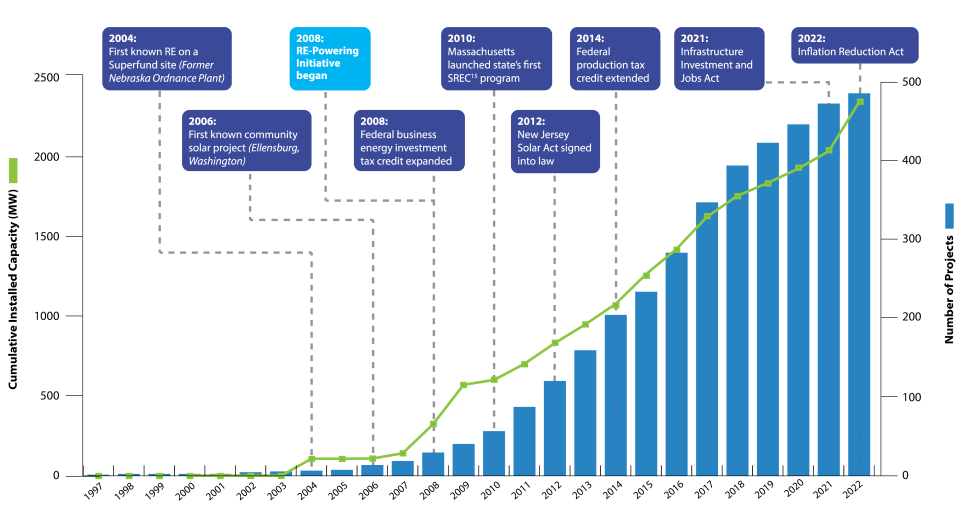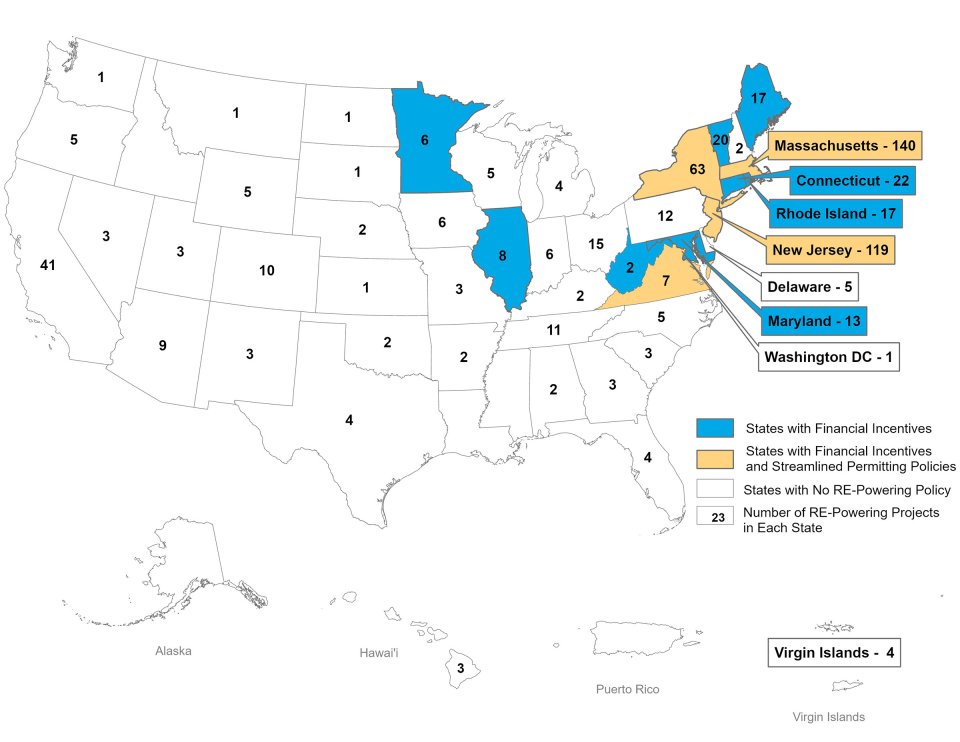Incentives and Policies
Incentives and Policies
Incentives and policies affecting renewable energy development may be available at federal, state, or local levels. In 2022, federal incentives for energy communities were enacted in the Inflation Reduction Act, and many states have their own incentives that support installing renewable energy on potentially contaminated lands. See Database of State Incentives for Renewables & Efficiency (DSIRE) for general information on federal, state, and local incentives and policies for renewable energy, and the descriptions below for information on incentives, policies, and their associated impacts related to potentially contaminated lands.
How Does Policy Impact RE-Powering?
There has been a steady growth in both the number of renewable energy installations on potentially contaminated lands and their overall capacity since 2007. As highlighted by the event timeline below, some of this growth can be attributed to increased knowledge about the concept, the introduction of EPA’s RE-Powering Initiative, and new incentives designed to increase renewable energy deployment. The Infrastructure Investment and Jobs Act and Inflation Reduction Act represent historic levels of investment in clean energy solutions. These recent legislative initiatives include provisions related to RE-Powering projects that promote investment in rural communities and expand access to affordable clean energy.

Federal Incentives and Policy
The Inflation Reduction Act includes bonus tax credits for installing wind and solar on brownfields, coal communities, and mining sites. To learn more about these incentives and bonuses, see Energy Community Tax Credit.
Inflation Reduction Act Information
For more information about the brownfields or Energy Communities bonus tax credit for renewable energy under the Inflation Reduction Act, see Supporting Brownfields Redevelopment using Tax Incentives and Credits.
State Incentives and Policy
States with the most renewable project development on contaminated lands, landfills, and mine sites typically have fostered, designed, and implemented longstanding, state-specific programs that prioritize the reuse of underutilized lands. The RE-Powering Policy Map shows the impact of certain RE-Powering policies at the state level.

RE-Powering policies include state financial incentives (including procurement requirements) and streamlined processes for the permitting or environmental reviews that are required for the development of renewables on potentially contaminated land. For example, Massachusetts, New Jersey and New York all have long-standing state policies and incentives that encourage the development of solar on landfills and brownfields, which is evidenced by the number of developed projects in these states. West Virginia may see future increases in renewable project installations on contaminated lands due to legislation passed in 2020 that created the Renewable Energy Facilities Program, which provides preferential electric utility cost recovery for up to 400 MW of solar projects on former mining sites, closed landfills, brownfields and certain other preferred site types.

The following documents contain information about existing state policies as well as how to develop and implement an effective state policy that results in increased renewable energy development.
- State Program Selection and Design Tips (pdf) (2.47 MB)
- Examples of State Policies Supporting Renewable Energy Development on Landfills, Formerly Contaminated Lands, and Mines - Thumbnails of state programs (pdf) (125 KB)
- Profiles of State Programs for Renewable Energy Development on Landfills, Mines, and Contaminated Sites (pdf)
RE-Powering assisted the State of Michigan and the Commonwealth of Virginia with the following summaries of “RE-Powering” programs and best practices from other states in relation to Michigan’s and Virginia’s goals for renewables on potentially contaminated lands:
- Summary of “RE-Powering” State Programs for the Reuse of Virginia Landfills & Brownfields for Solar – June 2022 (pdf)
- Summary of State Programs for the Reuse of Brownfields, Landfills, and Former Mines for Renewable Energy in Michigan – April 2023 (pdf)
RE-Powering’s webinar Unlocking Brightfields Potential: State Programs to Encourage Renewable Energy Siting on Contaminated Lands - RE-Powering America's Land Initiative provides information and examples of state programs that encourage renewable energy on contaminated lands. This webinar explores how state-based programs can increase renewable energy projects on landfills, brownfields, mines, and other contaminated lands. It discusses common types of state programs along with information and tips on program selection, design, implementation, and potential impacts.
